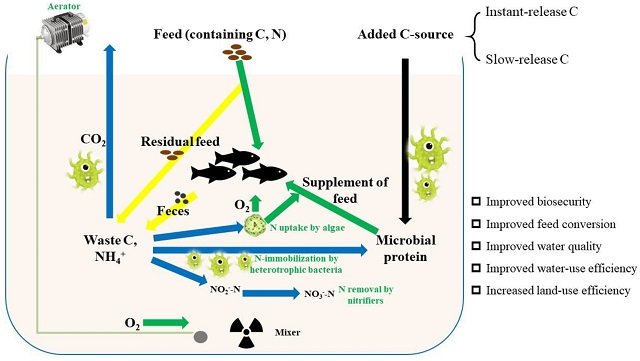
One of the key challenges in implementing biofloc technology (BFT) in aquaculture is the significant loss of carbon. A scientific review article by researchers from Jiangsu University discusses the potential effects of various C/N ratios, types of carbon sources, inclusion strategies, and technology integration regarding the optimized use of carbon in biofloc technology applied to aquaculture.
The Importance of the C/N Ratio in BFT
Biofloc technology relies on maintaining a C/N (carbon/nitrogen) ratio above 10. This is essential to enable heterotrophs, organisms that obtain their energy from organic compounds, to assimilate the toxic nitrogen present in the system. However, this high C/N ratio often leads to significant carbon loss.
Carbon Loss in BFT Systems
The source of carbon is a key factor in managing a biofloc system, and various studies have investigated the types of carbon, the amount to be used, and inclusion strategies to improve BFT performance.
There are many recommendations for selecting and using carbon substrate according to the cultured animals to achieve the desired performance. The nutrient composition of the formed bioflocs is directly related to the type of carbon source added, ultimately affecting the growth of aquaculture animals.
The authors of the study highlight that unexpected carbon loss is often a reality that aquaculturists must face. For a biofloc system, carbon usage depends on factors such as the cultured species, stocking density, aeration, input composition, and microbial community structures.
“Optimizing carbon utilization is of great significance for controlling operating costs and reducing the risk of pollution. However, the issue of carbon loss in biofloc systems has not received the attention it deserves,” report the researchers.
Optimizing Carbon Utilization in BFT
Multiple organic carbon substrates are being applied to adjust C/N ratios in biofloc systems for aquaculture. The researchers categorize these substrates into two categories based on their dissolution rate in water: rapid and slow release.
Each of these categories has its advantages and disadvantages.
Optimization of Carbon Addition Strategy
According to the study, current research on carbon addition strategies in biofloc systems mainly focuses on improving water quality and biofloc quality to ensure the desired well-being of cultured animals.
They also report that few studies have investigated the frequency of carbon addition for optimization of the addition strategy.
“In general, neither changes in the carbon addition method nor increases in frequency have been effective in improving carbon utilization in the biofloc system. Therefore, more research is needed on the development of carbon addition strategies, facilitating carbon retention efficiency within the BFT,” report the researchers.
Challenges and Perspectives
Carbohydrates play a significant role in biofloc systems, and the benefits of applying carbohydrates have been extensively demonstrated in water quality, biofloc quality, and the performance of cultured animals.
However, excessive carbon emission from biofloc is an undesirable fact as it poses a significant threat to the ecosystem. In this regard, the study authors emphasize that a priority is to optimize carbon utilization in biofloc system operations.
The study authors report that further research is needed to optimize carbon utilization efficiency and reduce carbon emissions. They also emphasize that standardization of methods, techniques, and equipment is critical for the application of carbon in biofloc systems.
Conclusions
Although research on carbon utilization in biofloc technology is still in its early stages, this article highlights promising approaches to improve the sustainability of aquaculture.
Optimizing carbon utilization in BFT by adopting strategies such as slow-release carbon incorporation, experimenting with C/N ratios, and integrating with other technologies can help reduce losses and make aquaculture more sustainable.
Ultimately, biofloc technology has the potential to significantly contribute to global food security and the conservation of natural resources.
The study was funded by the National Natural Science Foundation of China, the Natural Science Foundation of Jiangsu Province, the Jiangsu Province Agricultural Science and Technology Independent Innovation Fund Project, the Priority Academic Program Development of Jiangsu Higher Education Institutions, and the Jiangsu University Senior Talent Fund Project.
Reference (open access)
Li, C.; Zhang, X.; Chen, Y.; Zhang, S.; Dai, L.; Zhu, W.; Chen, Y. Optimized Utilization of Organic Carbon in Aquaculture Biofloc Systems: A Review. Fishes 2023, 8, 465. https://doi.org/10.3390/fishes8090465

